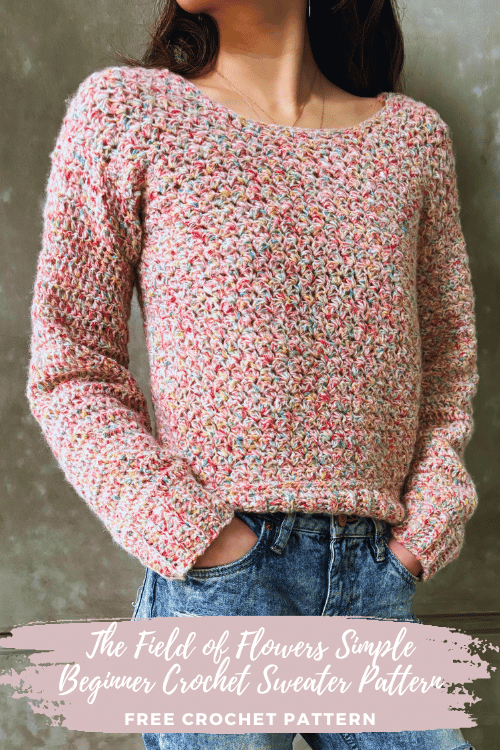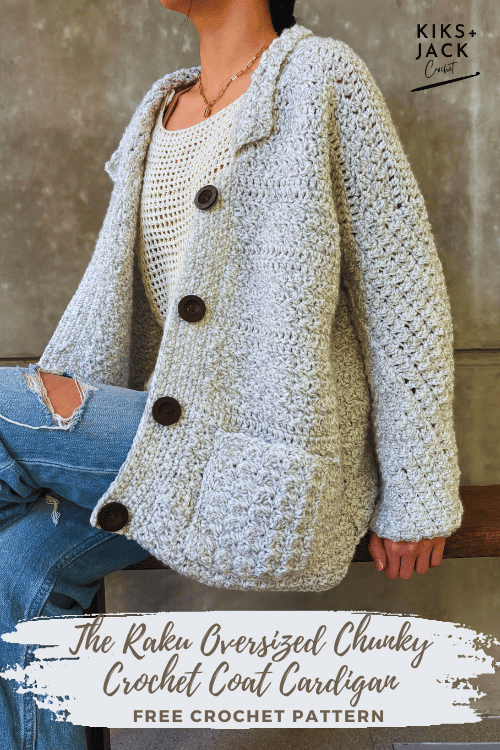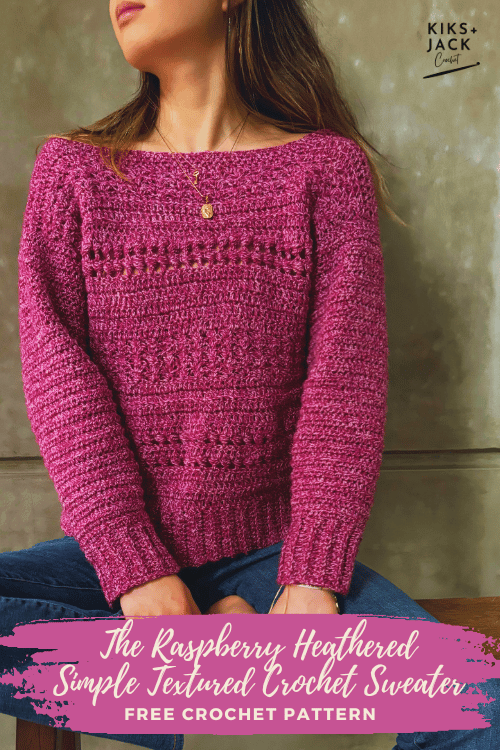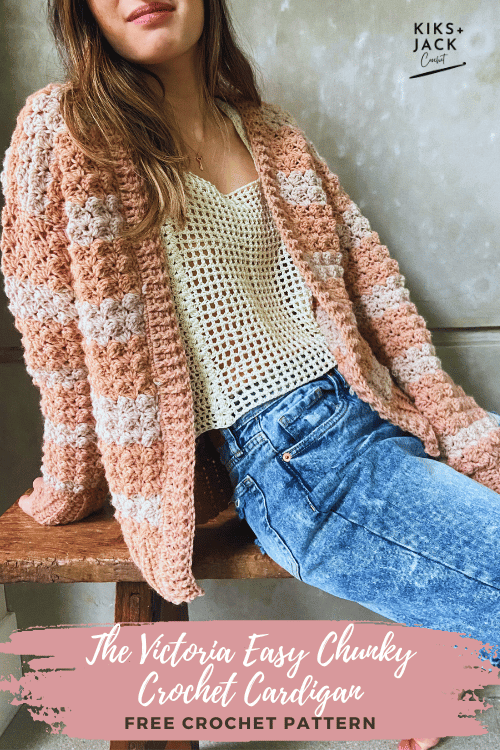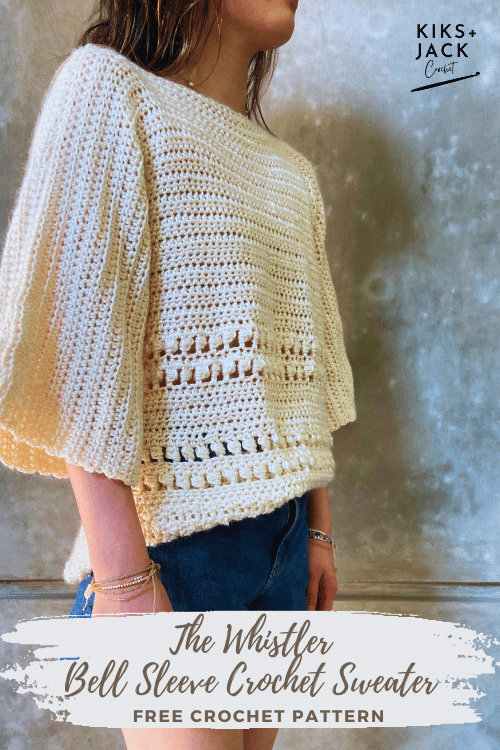The Field of Flowers Simple Beginner Crochet Sweater is a free and easy crochet pattern that is made to measure, size inclusive and designed to be intuitive and beginner friendly.
The Field of Flowers Simple Beginner Crochet Sweater, was created because we wanted a spring sweater with a subtle floral feel. We wanted it to remind us of the wildflower season in Australia. Back in Oz, we used to stop in front of open fields of wildflowers. The individual wildflowers were small and cute, but the real beauty was the thousands of flowers growing together to make up this beautiful carpet of colour. We love how this simple light crochet sweater reminds us of this beautiful part of the world.

The Field of Flowers Simple Beginner Crochet Sweater pattern is free when you access it online through your desktop or mobile device. We rely on ad revenue to meet the costs of running this website, along with coffee donations at https://ko-fi.com/kiksandjackcrochet. Thanks for supporting us and allowing us to keep providing free online patterns.
If you want to recreate a similar look you should look for yarn with a basic solid and that has tiny flecks of colour or texture to it. We found ours in this beautiful Loops & Threads yarn. It’s base colour is cream and the “tweed” part is a beautiful mixture of reds, yellows and greens. You can find all the details in the section “Crochet Materials” below.
Check out this other super simple beginner friendly crochet sweater pattern that uses the same yarn.
We use one of our favourite stitches in The Field of Flowers Simple Beginner Crochet Sweater to create the floral like pattern. We absolutely love this stitch because it is beginner friendly, fast to crochet, looks super fancy and provides beautiful texture. We kept the neckline simple and changed up the stitch pattern for the sleeves.

The Field of Flowers Simple Beginner Crochet Sweater is a classic Kiks + Jack Crochet sweater. Master this pattern, change up the yarn and you could easily have a whole wardrobe of these beautiful light sweaters. We kept this version a little shorter, however you could easily crochet this as an oversized longer sweater with this made to measure pattern.
Let’s get started on The Field of Flowers Simple Beginner Crochet Sweater
DESCRIPTION of The Field of Flowers Simple Beginner Crochet Sweater
The Field of Flowers Simple Beginner Crochet Sweater is a beautiful yet simple sweater that uses a gorgeous textured stitch. It can be customized to be shorter and cropped, or longer and more oversized with the made to measure instructions. This sweater features a beautiful ribbing at the bottom and ribbing on the sleeves. The neckline is kept simple and can also be customized to be wider or crocheted as a closer fit.
The Field of Flowers Simple Beginner Crochet Sweater is a free and easy crochet pattern available as a size inclusive made to measure pattern. It is a beginner friendly pattern and involves a stitch pattern that uses primarily single crochets and double crochets.
CROCHET MEASUREMENTS & SIZES for The Field of Flowers Simple Beginner Crochet Sweater
The pattern instructions are made to measure, based on your required measurements.
Kiks + Jack Crochet will always try to write patterns that are “made to measure” and size inclusive (versus graded sized patterns) so that crocheters can get the wonderful benefits of making a garment that fits perfectly. However we do appreciate taking measurements can be inconvenient for some and have also provided standard measurements for those who wish to use it.
To use the Field of Flowers Simple Beginner Crochet Sweater pattern you will need the following measurements and you should write them down for easy reference:
Chest/Bust: Measure around the fullest part of your chest/bust. Do not draw the tape too tightly.
Finished length: Measure from just below the waist (or where you would like the sweater to end) up to the top of your shoulder at your collarbone.
Armhole Depth: Measure from the top outside edge of the shoulder down to the armpit. You may want to check that this measurement – when doubled – is as big as your upper arm circumference (around your bicep). Typically it is, however every body shape is different. If your upper arm circumference is larger, take this measurement instead.
Arm Length: Measure from armpit to wrist (or where you would like the sleeve to end)
Wrist Circumference: Measure from one point on your wrist all around your wrist. Do not draw the tape too tightly.
Standard Measurements (For Reference)
If you would like to use standard sizing for the chest/bust – then for XS (S, M , L, XL, 2XL, 3XL, 4XL, 5XL) use approximately 28-30 (32-34, 36-38, 40-42, 44-46, 48-50, 52-54, 56-58, 60-62) inches or 71-76 (81-86, 91-96, 102-107, 112-117, 122-127, 132-137, 142-147, 152-158) centimetres.
If you would like to use standard sizing for armhole depth – then use approximately 6-6.5 (6.5-7, 7-7.5, 7.5-8, 8-8.5, 8.5-9, 9-9.5, 9.5-10, 10-10.5) inches or 15.5-16.5 (16.5-17.5, 17.5-19, 19-20.5, 20.5-21.5, 21.5-23, 23-24, 24-25.5, 25.5-26.5) centimetres
If you would like to use standard sizing for arm length – then for XS (S, M , L, XL, 2XL, 3XL, 4XL, 5XL) use approximately 16.5 (17, 17, 17.5, 17.5, 18, 18, 18.5, 18.5) inches or 42 (43, 43, 44.5, 44.5, 45.5, 45.5, 47, 47) centimetres
Note: The Field of Flowers Simple Beginner Crochet Sweater is designed as classic fit with positive ease.
CROCHET GAUGE
Using a hook size 5 (US size 8), approximately 14 double crochet across and 8 rows of double crochet in 4″ x 4″ (10 cm x 10 cm).
Note the Field of Flowers Simple Beginner Crochet Sweater is made to measure and can accommodate for different crochet gauges. However try to select a yarn with a similar gauge to this version.
CROCHET MATERIALS for The Field of Flowers Simple Beginner Crochet Sweater
This section contains product affiliate links. We may receive a small commission (at no extra cost to you) if you make a purchase after clicking on one of these links.
We promise to only recommend products that we love and that we use. Thank you for supporting our small business.
Yarn brand: Loops & Threads Weight 3/Light Worsted/DK. 150g per skein and 418 yards (or 382 m) per skein. Alternatively take a look here at yarn with flecks, speckles or “spotted colour” to achieve a field of flowers effect.
Approximately 2.5 skeins or 370 grams and 1031 yards (or 942m) used for Kiks + Jacks version (approximately XS) with a finished width of 18 inches and a finished length of 18 inches.
5 mm crochet hook (US size 8). We use many different crochet hooks and if you are looking for some great budget friendly ergonomic crochet hooks try these from Amazon. It comes in a set and the grip and the shape is amazing for beginner crocheters. However our absolute favourite, slightly more pricey crochet hooks are clover crochet hooks. You can buy then in a set or individually. We started our collection just purchasing the size 4 ,5 and 6.
Measuring Tape. We use a super budget friendly measuring tape. Make sure it has cm and inches (not all patterns are written with both). We are always crocheting on the go so we like our tapes small and compact and we put one in our design area, one in our bag and one in our car. Retractable works best! We use these super cheap mini measuring tapes from Amazon.
Stitch Markers. We use these locking crochet stitch markers from Amazon and these stitch markers that do not lock. They are cheap and colourful.
Blocking Pins. You should buy more pins than you think you need. If you are going to take the time to block don’t skimp on the pins. We like T shaped stainless steel pins that don’t rust when they get wet. We love these blocking T pins from Amazon and the tin means the pins don’t fall out on the floor.
Yarn Needle. Buy blunt needles with large eyes for yarn. We use these Yarn Needles because we like the convenient bottle, they are budget friendly and we get lots of them!
Scissors. We love these thread snippers because they are cheap, we get two of them AND they come with a case (some don’t). Don’t carry these without the case! After you use thread snippers you won’t want to snip with scissors.
CROCHET STITCHES & ABBREVIATIONS
The Field of Flowers Simple Beginner Crochet Sweater pattern is written with US terms.
ch = chain (With one loop on your hook, yarn over and pull through the loop)
sc = single crochet (Insert hook into desired stitch. Yarn over and pull through the stitch. You now have two loops on your hook. Yarn over and pull through all two loops)
dc = double crochet (Yarn over and insert hook into desired stitch. Yarn over and pull through the stitch. You now have three loops on your hook. Yarn over and pull through the first two loops. You now have two loops on your hook. Yarn over and pull through all two loops)
sl st = slip stitch (Insert hook into desired stitch. Yarn over and pull through the stitch and the loop on your hook)
BLO = back loop only
tch = turning chain
st = stitch
sk = skip stitch
* = repeat the instructions following the * as directed
Note unless stated otherwise turning chains do not count as a stitch if there are 1 or 2 chains and the turning chain does count as a stitch if there are 3 or 4 chains.
SUMMARY of CONSTRUCTION for The Field of Flowers Simple Beginner Crochet Sweater
The Field of Flowers Simple Beginner Crochet Sweater is made by first crocheting a back panel and an identical front panel. You will start by crocheting the ribbing and then continue to crochet the panels bottom up. You will then crochet a neckline opening in both panels.
After you have created the two panels, you will crochet the sleeve ribbing and then the sleeve panels. Finally you will seam the front panel and the back panels at the shoulder and then seam the sleeves directly on to the panels. You will finish The Field of Flowers Simple Beginner Crochet Sweater by crocheting a simple edge on to the neckline.
PERMISSIONS AND COPYRIGHT
Please do not publish or share The Field of Flowers Simple Beginner Crochet Sweater pattern as your own. You may crochet items to sell using this pattern with permission ([email protected]). Please link back to this post in exchange. Please do NOT use my photos as your own photos.
Crochet Pattern Instructions for The Field of Flowers Simple Beginner Crochet Sweater
Crochet the Back Panel Ribbing
ch 12
The height of our ribbing is approximately 2 inches. Based on our gauge this is approximately 12 chains. You can adjust the number of chains if you want to change the height of the ribbing or you are using a yarn with a different gauge.
Row 1: hdc in 3rd ch from hook, hdc in each ch across until end. Turn
Row 2: ch2, hdc BLO in each st across, on the last st hdc into the entire stitch. Turn
Repeat row 2 until the total length of the ribbing is equal to HALF of your “Chest/Bust Measurement” plus 1 inch.
K+J example: Our chest/bust measurement = 32 inches around. Half of 32 inches = 16 inches. We keep repeating row 2 until the total length of the ribbing reaches 17 inches (16 +1 = 17 inches)
Count the total number of rows.
K+J example: We counted a total of 40 rows to achieve a length of approximately 17 inches.
It’s a great time to check if you are completely happy with the width of the sweater before you crochet any further. Place the ribbing up at your waist and bust to see if the width (length of ribbing) is right for you. If you would like it to be wider and more loose, crochet a few more rows. If you would like the ribbing to be narrower and tighter, then you can frog (unravel) a few rows. Note that the width of the main body will increase a little more depending on your gauge.
Do not fasten off.
Crochet the Back Panel
You will now crochet down the long side of the ribbing that you just crocheted.
To calculate the number of stitches that you will crochet down the long side of the ribbing, calculate as follows:
| Calculation | Kiks+Jack Crochet Example |
| Count the number of rows in your ribbing | We have 40 rows in our ribbing |
| Multiply this by 1.5 (round up or down to a whole number if necessary) | 40 X 1.5 = 60 stitches |
| If this number is NOT a multiple of 3 then increase it until it is a multiple of 3 (divides into 3 evenly). If this number is already a multiple of 3, then leave it as is. | 60 is a multiple of 3 so we keep it as is. |
| Add one more chain | 60 + 1 = 61 stitches |
Row 1: Using the working yarn, ch1, sc into the first st, sc across the ribbing the number of stitches you calculated above in total. Turn
In K+J example above we will crochet 61 single crochets across the long side ribbing.
Tip: You may want to place some stitch markers across the ribbing at the 1/4, 1/2 and 3/4 marks. Then divide the number of stitches you need to crochet by 4 to give you an approximate idea of how many stitches you need to crochet in each quarter so you can ensure you are crocheting evenly.
Row 2: ch1, sc into 1st st, sc across. Turn
Row 3: ch2, 2dc in 1st st, *sk next 2 st, [1sc, 2dc] in next st, rep from * towards the end of row with 1sc in last st. Turn
The next row 4 should look a little like placing [1sc, 2dc] between the clusters from the previous row.
Row 4: ch1 (counts as a st), 2dc in 1st st, *sk 2dc [1sc, 2dc] in next st, rep from * towards the end of row with 1sc in last st. Turn
Repeat row 4 until the total length including the ribbing is equal to your “Finished Length Measurement” minus 2 inches.
Fasten off.
Crochet the Front Panel
Repeat all the instructions under Back Panel Ribbing and Back Panel. However repeat row 4 until the total length including the ribbing is equal to your “Finished Length Measurement” minus 3 inches. If you want a deeper or lower neckline, then instead of 3 inches, you can increase it to 4+ inches).
Measure the Neckline on the Back and and Front Panel
We will now crochet the neckline on to the back and front panel. We like to crochet the back and front panel first without the neckline so that we can “try it on”. This will allow you to measure out the perfect neckline width first, before you crochet it.
Measure 5 inches in from the left edge of the back panel and place a locking stitch marker (we will be adjusting the exact inches that is right for you shortly). This will be the start of your neck opening. Repeat the same on the right side of the back panel.
Measure out the same distance on the front panel on both sides and place a locking stitch marker.
Attach the two panels together lining up the 4 stitch markers using the locking stitch markers. Place the panels over your head and check whether you need to make adjustments to the neck opening. If you would like it tighter then move the stitch markers closer to your neck. If you would like the neck opening wider, then move the stitch markers away from your neck. Make sure it is the same distance (use a measuring tape) on either side and on the front and back panel.
Make sure the final stitch markers are placed between a cluster (first st of a cluster) and not in the middle of a cluster.
For this design we are only adding a simple edge to the neckline. Therefore the neckline width you measure out will be similar to the final width of the neckline. (If you were planning to add a thicker ribbing to the neckline you should take this into consideration).
For reference, Kiks + Jack crocheted a size XS with a total width of approximately 18 inches. We measured 6 inches from each side as we wanted a slightly tighter neckline.
Crochet the Neckline on the Back and and Front Panel
Crochet the Neckline on the Left Side Back Panel
Once you are satisfied with the neckline measurements, we will start to crochet it. Start with the back panel and attach the yarn to the first stitch near the left shoulder.
Row 1: ch1 (counts as a st), 2dc in 1st st, *sk 2dc, [1sc, 2dc] in next st, rep from * towards the stitch marker, ending with 1sc in the stitch with the stitch marker. Turn
Row 2: ch1 (counts as a st), 2dc in 1st st, *sk 2dc, [1sc, 2dc] in next st, rep from * towards the end with 1sc in the tch. Turn
Repeat row 2 until the total back panel (ribbing + main back panel + neckline) is equal to your “Finished Length Measurement“.
In Kiks + Jack’s version, we crocheted 5 rows of neckline in total.
Fasten off.
Crochet the Neckline on the Right Side Back Panel
You will now crochet on the right side of the back panel. Attach a yarn at the second stitch marker that is marking out the neckline.
Row 1: ch1 (counts as a st), 2dc in 1st st, *sk 2dc [1sc, 2dc] in next st, rep from * away from the stitch marker and towards the end of the row, ending with 1sc in top of tch. Turn
Row 2: ch1 (counts as a st), 2dc in 1st st, *sk 2dc [1sc, 2dc] in next st, rep from * towards the end of the row, ending with 1sc in the tch. Turn
Repeat row 2 until the total back panel (ribbing + main back panel + neckline) is equal to your “Finished Length Measurement“. ie. the neckline is the same length on the right side and left side of the back panel.
Crochet the Neckline on the Right Side and Left Side Front Panel
Repeat the instructions for the front panel, for both the left side and right side. You should have a slightly deeper neckline for the front panel compared to the back panel, although this is customizable.
In Kiks + Jack’s version, we crocheted 6 rows for the front neckline in total.
Fasten off.
Crochet the Sleeve Panel (Make 2)
We will now crochet the two sleeve panels starting with the cuff. Remember you will need to make two identical sleeve panels.
Crochet the Sleeve Panel Ribbed Cuff
ch 12
The height of our ribbing is approximately 2 inches. Based on our gauge this is approximately 12 chains. However you can adjust the number of chains if you want to change the height of the ribbing or you are using a yarn with a different gauge.
Row 1: hdc in 3rd ch from hook, hdc in each ch across until end. Turn
Row 2: ch2, hdc BLO in each st across, on the last st, hdc into the entire stitch. Turn
Repeat row 2 until the ribbed cuff is equal to your “Wrist Circumference Measurement” + 2 inches. Make sure it fits comfortably and is not too tight.
Count the number of rows (we crocheted 20 rows).
Do not fasten off. Turn your ribbing. You will now crochet down the long side of the ribbing.
Crochet the Main Sleeve Panel
Note there is a change in the stitch pattern for the sleeve compared to the main body panels.
To calculate the number of stitches across the ribbing, calculate as follows:
| Calculation | K+J Example |
| Count the number of rows in the sleeve cuff | We counted 20 rows in our cuff |
| Double the number | 20 x 2 = 40 |
Row 1: ch1, sc across the ribbing the total stitches calculated in the table above. Turn.
In K+J example, we would crochet 40 sc across the ribbing. It is going to be tight, however this is normal. You may need to crochet 2sc in to the same stitch to fit in all the stitches evenly.
Row 2: ch3, dc in the 2nd st, dc across the row until the end. Turn.
Repeat row 2 and you should see that the width of the sleeve panel will start to fan out and increase. After a number of rows, this increase will slow down (it will depend on your gauge). At this point take a measurement of the width. You may need to increase this width (if necessary) so that it equals at least [2 x armhole depth measurement + 1 inch].
If you do not need to increase the sleeve panel width, then you should keep repeating Row 2 until your sleeve including the cuff reaches your desired “Arm Length Measurement“. This was the case for Kiks + Jack’s version.
If you do need to increase the width, then you will do this by crocheting Row A (increasing row) and then Row B (non increasing row) as outlined below:
Row A (increasing row): ch3, 2hdc in the 2nd st, dc across the row, 2dc in the end st. Turn
Row B (non increasing row): ch3, dc in the 2nd st, dc across the row until the end. Turn.
As you repeat Row A and Row B in that order, the width of your sleeve panel will start to increase again. Crochet Row A and Row B in that order until the width of your sleeve panel is equal to at least [2 x armhole depth measurement + 1 inch].
NOTE: You may only need to crochet a few Row As, before you reach your desired width. It really will depend on your arm measurements and wrist size.
When the width of your sleeve panel reaches [2 x armhole depth measurement + 1 inch] repeat Row B only (non increasing row) until the sleeve panel including the cuff, is equal to your “Arm Length Measurement“.
Note we like oversized sleeves and crochet long sleeves past our wrist. However we will show you how to check the sleeve length again under “Assembly” so that you can ensure you have the perfect fit.
Fasten off.
Remember you need to crochet two identical sleeve panels.
Assembling the Field of Flowers Simple Beginner Crochet Sweater
Kiks + Jack Crochet highly recommends blocking all your panels before assembly. Blocking your panels will set your panels to the shape and size you want and give it a polished look.
We block our panels by pinning all the pieces on to an old yoga mat and manipulating the shape and edges so the front and back panel are similar and the two sleeve panels are similar. We then spray it with water focusing on the edges and ensuring it is well saturated. Do not remove the pins until the panels are completely bone dry.
Step 1: Seam the Front and Back Panel at the shoulder. Place the front and back panels together with the right sides facing together. With a yarn needle, seam the two panels together across the shoulders starting from the edge and across. Fasten off.
Step 2: Line up your sleeves at the midway point to the shoulder and seam. Open up the two panels (now seamed at the shoulders) so that the right side is facing the floor and the wrong side is facing upwards. Take one of your crocheted sleeves and fold it in half lengthways. Place a stitch marker at the top of your sleeve at the centre point. With the wrong side of the sleeve facing up, attach this stitch marker to the left edge of the left shoulder seam.
Customization Tip: It is a good time to check the length of your sleeve. You can “seam” it with a few locking stitch markers to the main panel. Try it on. If you would like the sleeve to be longer (eg. some like the cuff to be almost at the knuckles vs the wrist), you can remove the knot on your sleeve panel (where you fastened off) then add a few more rows on to your sleeve. Or you can reduce rows if you like your sleeves shorter by removing the knot first and pulling out (frogging) a few rows. Make sure you do the same on the second sleeve so they are identical.
When everything is perfect, using a yarn needle and matching yarn, seam the sleeves to the main panels (wrong side facing up) – see first diagram below (for illustrative purposes only).
Do the same on the right side with the other sleeve.
Step 3: Seam the sides of the sweater and the bottom of the sleeve together. Fold the two panels and sleeve panels at the seamed shoulders so that your sweater is facing wrong side out. With a yarn needle and matching yarn, seam the sides of the two panels together up to the armpit and along the bottom of the sleeve. See second diagram below (for illustrative purposes only)

Fasten off.
Step 4: Add the ribbing to the neckline
Turn the sweater right side out. Attach a yarn to the side of the neckline.
Round 1: ch1, sc in the first st, sc evenly around the neckline into every st. The key is to keep the sc even. When you complete the round, sl st to join at the top of the tch.
You may want to crochet another round of Round 1. We liked the simplicity of the neckline and stopped after round 1.
Fasten off.
Finish & Celebrate the Field of Flowers Simple Beginner Crochet Sweater
Weave in all your ends.
Congratulations you have finished The Field of Flowers Simple Beginner Crochet Sweater and we hope you enjoyed this free crochet pattern.
We love and live off coffee. If you would like to buy us a coffee you can at: https://ko-fi.com/kiksandjackcrochet. Thank you!
It would be amazing to see a photo of your completed work on instagram. Tag us your version of The Field of Flowers Simple Beginner Crochet Sweater @kiksandjackcrochet.
Follow us on social media for new pattern releases and work in progress.

